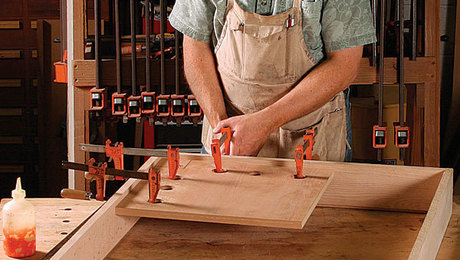I’ve lately obtained a shocking variety of questions on clamps – in all probability as a result of with time at residence, individuals are constructing issues. And whereas I believe it’s true that you can’t have too many, you can have too many ineffective ones. So right here’s my tackle what clamps you need in a typical woodworking store, within the order that I exploit them most. Note that the majority of what I construct is on the massive aspect, so your wants may fluctuate.
Parallel-jaw clamps (often known as Ok-bodies and cupboard clamps)

These are the workhorse clamps within the store the place I train. I like the massive jaws (although I typically use simply the tricks to apply strain to a selected level when gluing up dovetails), and I like that they sit flat on a bench (or on the ground), which makes them awfully helpful for panel glue-ups. You can press all of the items down flat to the bars as an excellent start line to align the workpieces. We have them ranging in lengths from 12 in. to 50 in.; we’ve got essentially the most (12) within the 26-in. size. The two largest purveyors of this model of clamp are Bessey and Jet. The handles on the previous Besseys are wooden, so you can drill a gap by means of these so as to add a tommy bar to tighten them a bit extra simply; on the newer Besseys, the (I believe hole) handles have a grippy floor which helps with tightening. But I desire the older wooden handles. The Jets have a faceted deal with, and may thus be extra simply gripped and tightened. I desire the Jets, however both are nice for many jobs. (One of the good issues in regards to the Bessey clamps is that in the event that they begin to slip, you can alter them by inserting an Allen wrench into the little gap behind the deal with on the decrease jaw – flip the set screw a couple of quarter flip to show new threads.)


Bar clamps

Old iron bar clamps – significantly these with the saw-tooth sample to find the jaw – are glorious. Thanks to the offset deal with, you can exert much more strain with these than with Ok-bodies, in order that they’re indispensable for big, heavy-duty work (resembling gluing up a workbench high) or pulling tight joints residence (not that you ought to do this…), or closing up jigs when bending. They additionally work nice on smaller work, however they weigh loads – so I often attain for the Ok-bodies except I need to exert further strain. We have about six of those clamps, all in 50-in.-plus lengths (and if I ever see them for an honest worth at a yard sale or vintage retailer, I’ll snap them up). There are additionally newer, aluminum bar clamps, and there are all types of the way for making these stronger (they bend simply below not a lot pressure). But I’d relatively top off on Ok-bodies and classic bar clamps.
Pipe clamps
These are cheap, which makes them enticing. They weigh a ton, which to me is unattractive, plus the jaws on most of them are fairly small, which limits their usefulness. Get 3/4-in.-diameter pipes; the 1/2-in. aren’t inflexible sufficient for large-scale work. (And if you can, get rubber pads to cowl the jaws, or epoxy some scrap on the jaws. The steel jaws on these will bugger your work – quick.) Even although these aren’t my favourite, I inherited an honest choice of longer lengths that I exploit at residence, most frequently for home renovation work. I convey them to the Lost Art Press store after I’m educating an English instrument chest class, although, as a result of we need all of the lengthy clamps we are able to get for that class. One factor to remember in case your clamps are uncooked iron: they are going to stain your work (particularly if it’s oak). So take care. (I do know plenty of folks like these as a result of couplers permit you flip quick clamps into longer ones. But after they get too lengthy, they’re awfully heavy and unwieldy. Still, if wants should …)
Hand screws

These may appear old school, however they’re nice to make use of as vises, say for holding work on edge on the bench. I additionally use them loads for exerting strain in a selected spot. You can simply lower notches within the jaws for holding odd-shaped work. I’ve possibly eight at residence in numerous sizes, and we’ve got about the identical quantity on the store. The largest sizes turn out to be useful most frequently – both as an ersatz twin-screw vise or to carry work on edge. The smaller ones see some use to carry odd-shaped items on the bandsaw.
F-style clamps

Honestly, I most frequently use these to clamp issues to my bench on the edge when a holdfast gained’t attain. But they’re nice for gluing up small work and exerting pin-point strain (say to shut a shoulder in a dovetailed drawer field). I do want we had a couple of extra deep-reach F-styles – these are useful for gluing on the highest mud seal on a instrument chest (I construct lots of instrument chests). The ones that get essentially the most use round listed below are the tiny ones. The greatest ones? Old ones, with heavy castings and deep Acme-thread screws.
One-handed clamps (often known as ratcheting clamps)
I usually use these to connect fences to the tablesaw or to carry issues in place whereas I exploit two fingers to use a stronger clamp. Still, it’s good to have a handful round.
Spring clamps

We have lots of these, however I usually use them solely to carry issues in place throughout a one-person glue-up after I need an additional hand. But they’re made to suit the typical man hand, so I can’t truly use at the least half of ours one-handed, which makes them form of ineffective to me. And those I can use with one hand exert solely a little bit strain, in order that they don’t maintain issues in place very properly. But they do turn out to be useful occasionally.
Nails
When making use of moldings, it nearly at all times simpler to shoot a couple of brads into the work than to attempt to clamp it in place.
Sentice clamps
Because I’m nearly at all times constructing sq. casework, I don’t typically need a strap clamp – I exploit these so hardly ever, actually, that I’m undecided the place we retailer them; I at all times should ask. But if I had been constructing demilune tables, I’d wish to know the place they dwell.
Yes, there are all types of different clamps, together with specialty clamps for miters and the like – however we don’t use them a lot. Again, your wants could fluctuate, however the above clamps are adequate for the wide range of labor that goes on the place I train, and for all my work from home, whether or not on furnishings or on my home.
 |
Hand-Screw How-To |
 |
Improving the Grip on Clamp Handles |
 |
When Clamps Fall Short |













